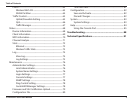
8D-Link DAP-2690 User Manual
Section 1 - Product Overview
Standards-Based Technology
The DAP-2690 Wireless Access Point utilizes the 802.11a, 802.11b, 802.11g, and 802.11n standards.
The IEEE 802.11n standard is an extension of the 802.11a, 802.11b, and 802.1g standards that came before it. It increases the maximum wireless
signal rate up to 300 Mbps* within both the 2.4 GHz and the 5 GHz bands, utilizing OFDM technology.
This means that in most environments - within the specied range of this device - you will be able to transfer large les quickly, or even watch a
movie in MPEG format over your network without noticeable delays. This technology works by transmitting high-speed digital data over a radio
wave utilizing OFDM (Orthogonal Frequency Division Multiplexing) technology. OFDM works by splitting the radio signal into multiple smaller
sub-signals that are then simultaneously transmitted at dierent frequencies to the receiver. OFDM reduces the amount of crosstalk (interference)
in signal transmissions.
The D-Link DAP-2690 will automatically sense the best possible connection speed to ensure the greatest possible speed and range.
Note: 802.11n oers the most advanced network security features available today, including WPA.
*Maximum wireless signal rate derived from IEEE Standard 802.11g, 802.11a and 802.11n specications. Actual data throughput will vary. Network conditions and environmental
factors, including volume of network trac, building materials and construction, and network overhead, lower actual data throughput rate. Environmental conditions will
adversely aect wireless signal range.


















